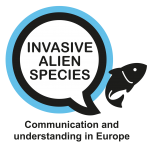Home » Aquatic Recreation Cluster (IAS)
Aquatic Recreation Cluster (IAS)

Introduction to the Aquatic Recreation (Angling) Cluster
Recreational fishing is a leisure activity enjoyed by many people. Unfortunately, invasive alien species (IAS) can travel with people to new habitats. There are many IAS that can stowaway and be spread on fishing tackle and associated equipment (e.g. Personal Protective Equipment, boats, trailers).
Many invasive alien plant species, such as floating pennywort (Hydrocotyle ranunculoides) and Nuttall’s waterweed (Elodea nuttallii) are introduced as small fragments on boats or angler’s nets, and can readily propagate and proliferate within waters into which they are unintentionally introduced.
Likewise, invasive alien invertebrates or pathogens can be inadvertently spread via anglers and angling equipment. Although anglers are becoming more aware of the negative environmental impact of IAS, several have been introduced (particularly in the past) by anglers or through the use of live bait.
All these IAS can result in substantial biodiversity loss. In addition, the spread and proliferation of these IAS can render waters unsuitable for angling (or other recreational use), can increase the risk of flooding, and potentially cause catastrophic losses in native fish and invertebrate communities.
Aim of Establishing the Aquatic Ornamental Stakeholder IAS Platform
The objective of the aquatic recreation platform is to foster a constructive dialogue within and among stakeholder organisations and competent authorities involved in the cluster of pathways (both on “impacting” and “impact” sides) and to develop joint initiatives to address the problem.
- discuss IAS and the required prevention measures related to the cluster of pathways,
- discuss IAS of Union concern and the improvement of the implementation of the prevention measures provided for in the IAS Regulation,
- discuss options for stakeholders involved in the introduction and spread of IAS (cause) which may help them to continue and expand their activities, while reducing the associated risks (e.g. by replacing alien species by native species) and contributing to halting the loss of biodiversity,
- co-operate on the development and joint implementation of an IAS prevention campaign for the aquatic ornamental cluster,
- discuss how prevention and control of IAS can support the objectives of nature conservation in protected areas, particularly in Natura 2000 areas.
The platform is not intended to act as a European Commission “Expert Group” or a similar entity with consultative functions but instead aim to exchange good practice between one another and come up with new ways to deal with IAS.
Role of the Project Team/Platform Secretariat
The team’s role is an advisory neutral third party in support of all the other parties. The solutions will have to be discussed and agreed between the stakeholders. The project team will facilitate this dialogue and provide input from experts on IAS as desired by the participating platform members.
- Neutrality with regard to the issues under discussion. The team would only make suggestions on the process to be followed but this would also be adaptable depending on requests of the participants.
- Equality in supporting every platform member equally in terms of understanding what is important to her/ to him. Considering all viewpoints as being equally valid and taking proper account of knowledge shared from different sources.
- Transparency with regard to the decisions the team makes on the process and the reasons for making them
- Confidentiality with regard to who provides the team with what information. Information gathered (e.g. through interviews) will be reported to the Commission as well as to the other stakeholders involved but no information will be linked to a specific individual.